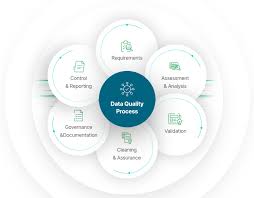Data quality is often paradoxical—simple in its fundamentals, yet challenging in its details. A solid data quality management program is essential for ensuring processes run smoothly.
What is Data Quality?
At its core, data quality means having accurate, consistent, complete, and up-to-date data. However, quality is also context-dependent. Different tasks or applications require different types of data and, consequently, different standards of quality.
Data that works well for one purpose may not be suitable for another. For instance, a list of customer names and addresses might be ideal for a marketing campaign but insufficient for tracking customer sales history.
There isn’t a universal quality standard. A data set of credit card transactions, filled with cancellations and verification errors, may seem messy for sales analysis—but that’s exactly the kind of data the fraud analysis team wants to see.
The most accurate way to assess data quality is to ask, “Is the data fit for its current purpose?”
Steps to Build a Data Quality Management Process
The goal of data quality management is not perfection. Instead, it focuses on ensuring reliable, high-quality data across the organization. Here are five key steps in developing a robust data quality process:
Step 1: Data Quality Assessment
Begin by assessing the current state of data. All relevant parties—from business units to IT—should understand the current condition of the organization’s data. Check for errors, duplicates, or missing entries and evaluate accuracy, consistency, and completeness. Techniques like data profiling can help identify data issues. This step forms the foundation for the rest of the process.
Step 2: Develop a Data Quality Strategy
Next, develop a strategy to improve and maintain data quality. This blueprint should define the use cases for data, the required quality for each, and the rules for data collection, storage, and processing. Choose the right tools and outline how to handle errors or discrepancies. This strategic plan will guide the organization toward sustained data quality.
Step 3: Initial Data Cleansing
This is where you take action to improve your data. Clean, correct, and prepare the data based on the issues identified during the assessment. Remove duplicates, fill in missing information, and resolve inconsistencies. The goal is to establish a strong baseline for future data quality efforts.
Remember, data quality isn’t about perfection—it’s about making data fit for purpose.
Step 4: Implement the Data Quality Strategy
Now, put the plan into action by integrating data quality standards into daily workflows. Train teams on new practices and modify existing processes to include data quality checks. If done correctly, data quality management becomes a continuous, self-correcting process.
Step 5: Monitor Data Quality
Finally, monitor the ongoing process. Data quality management is not a one-time event; it requires continuous tracking and review. Regular audits, reports, and dashboards help ensure that data standards are maintained over time.
In summary, an effective data quality process involves understanding current data, creating a plan for improvement, and consistently monitoring progress. The aim is not perfection, but ensuring data is fit for purpose.
The Impact of AI and Machine Learning on Data Quality
The rise of AI and machine learning (ML) brings new challenges to data quality management.
For AI and ML, the quality of training data is crucial. The performance of models depends on the accuracy, completeness, and bias of the data used. If the training data is flawed, the model will produce flawed outcomes.
Volume is another challenge. AI and ML models require vast amounts of data, and ensuring the quality of such large datasets can be a significant task.
Organizations may need to prepare data specifically for AI and ML projects. This might involve collecting new data, transforming existing data, or augmenting it to meet the requirements of the models. Special attention must be paid to avoid bias and ensure diversity in the data. In some cases, existing data may not be sufficient or representative enough to meet future needs.
Implementing specific validation checks for AI and ML training data is essential. This includes checking for bias, ensuring diversity, and verifying that the data accurately represents the problem the model is designed to address.
By applying these practices, organizations can tackle the evolving challenges of data quality in the age of AI and machine learning. Create a great Data Quality Management Process.













